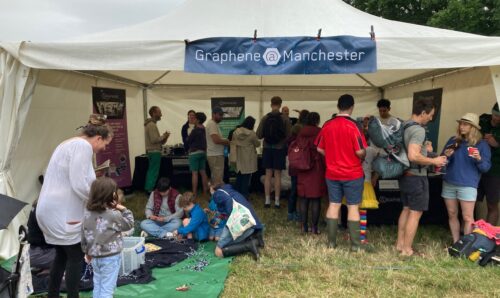Creating a scalable route for 2D materials
Research 29 August 2019
Eliott Higgins, a PhD student in the School of Natural Sciences discusses his recently published research paper and what it means for the future of two-dimensional materials.
Graphene is the world’s first two-dimensional material. Many more time stronger than steel, more conductive than copper and a million times thinner than a human hair, no other material has as many superlative properties and potential uses.
The isolation of graphene opened the doors for the exploration of other 2D materials. Research at The University of Manchester has now evolved from the initial work on simple graphene to new 2D crystals: hexagonal boron nitride, tungsten disulphide, molybdenum disulphide and more, each has a range of different properties.
One of the stumbling blocks to the adoption and commercialisation of 2D materials is the ability to produce these materials at scale.
Overcoming the barrier
For the first time a team of researchers at The University of Manchester have synthesised the 2D material molybdenum disulphide (MoS2) at room temperature, offering a new, potentially scalable synthesis route to this material and other 2D materials.
A complementary 2D material to graphene, MoS2 can display both semiconducting and metallic behaviour, which means that it has interesting applications in electronics, energy storage devices like batteries and as an electrocatalyst for hydrogen evolution.
By developing a production method capable of generating inexpensive, large-area pristine films of 2D materials a critical barrier could be overcome, enabling the commercial exploitation of this class of materials.
Traditionally, large-scale production of 2D materials is achieved by “bottom-up” method such as chemical vapour deposition (CVD), where graphene is grown on a hot copper of nickel foil, or by “top down” methods such as liquid-phase exfoliation (LPE), this method exfoliates graphite in a solvent to produce an ink that contains particles of graphene. However both methods have specific problems which hinder their commercial application.
CVD is expensive and requires dedicated high vacuum equipment, reactive gas feeds and the need to remove the underlying growth substrate. LPE of either natural or synthetic materials, albeit inexpensive, produces a polydisperse product with varying material thickness and lateral sizes. LPE also often needs surfactants to improve the stability and concentration of exfoliated material, which impacts the quality of the final product.
An alternative method
An alternative to these two production methods is liquid−liquid (L/L) interfacial assembly of 2D materials, where thin films assemble at the interface between two immiscible liquids. This is driven by a reduction in the total free energy of the system as a result of the reduction in the organic/water interfacial area.
The team have developed a method of synthesising large area monocrystalline MoS2 thin films from molecular precursors, as previous studies had shown that thin films of metal chalcogenides like MoS2 can be produced from the decomposition of molecular precursors at elevated temperatures and by tribological stress.
The method allows the material to be produced over a few hours at room temperature without stirring or the addition of any surfactants, producing MoS2 at the interface between two liquids, which can be isolated onto substrates of choice.
The formation of MoS2 can be accelerated by carefully considering the choice of organic solvent and changing the pH of the aqueous phase. This method is thought to be the first reported room temperature synthesis and offers a potential solution to scalable 2D material production.
This synthesis route not only offers a safe, inexpensive production methodology with non-intensive processing conditions, but it is believed to be generic, i.e. not restricted to the synthesis of MoS2. This methodology should be transferrable to other 2D materials, meaning the scope and impact of this production method on future production methodologies could be substantial. The method also has opportunities to offer roll-to-roll coating of 2D material onto substrates, delivering large area coating of 2D materials onto substrates at low cost.
Tackling the challenge of the scale up of these advanced materials is fundamentally important in the adoption of these materials in industry.
Two-dimensional materials have huge potential, providing the potential to create designer materials. By layering these materials similar to layering Lego bricks these stacks of 2D materials known as heterostructures allows us to create materials with limitless potential without being hindered by the properties of existing materials. This potential can only be realised if methods like this can be developed.
Words by Eliott Higgins.
For more information about this research, please see link below to the paper:




